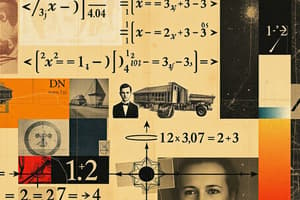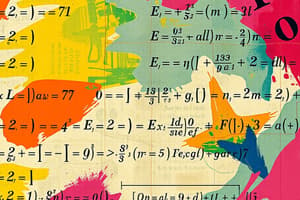Podcast
Questions and Answers
Evaluate the expression $5(x - 2) + 3y$ when $x = 5$ and $y = -1$.
Evaluate the expression $5(x - 2) + 3y$ when $x = 5$ and $y = -1$.
- 12 (correct)
- 22
- 10
- 18
Simplify the expression: $4(a + 2b) - 2(3a - b)$
Simplify the expression: $4(a + 2b) - 2(3a - b)$
- $-2a + 10b$ (correct)
- $10a - 10b$
- $-2a + 6b$
- $10a + 6b$
Identify the constant term in the expression: $9x - 4y + 6$.
Identify the constant term in the expression: $9x - 4y + 6$.
- $9x$
- $-4y$
- 9
- 6 (correct)
What is the coefficient of $x$ in the expression: $x - 5y + 3z$?
What is the coefficient of $x$ in the expression: $x - 5y + 3z$?
Evaluate $18 \div 3 + 2 \times (5 - 1)$.
Evaluate $18 \div 3 + 2 \times (5 - 1)$.
Simplify: $2(x^2-1) - (x^2+3)$
Simplify: $2(x^2-1) - (x^2+3)$
In the equation $y = -3x + 7$, what does the constant represent?
In the equation $y = -3x + 7$, what does the constant represent?
Identify the coefficient of the 'a' term in the following expression: $5a + b - 3c + 8$
Identify the coefficient of the 'a' term in the following expression: $5a + b - 3c + 8$
Simplify and expand: $(x + 4)(x - 2)$
Simplify and expand: $(x + 4)(x - 2)$
What is the value of the expression $4a^2 - 2b + c$, when $a = -1$, $b = 3$, and $c = -2$?
What is the value of the expression $4a^2 - 2b + c$, when $a = -1$, $b = 3$, and $c = -2$?
Flashcards
Evaluating Expressions
Evaluating Expressions
Substituting values for variables and simplifying using order of operations.
Like Terms
Like Terms
Terms with the same variable raised to the same power.
Constant
Constant
A fixed number in an expression without any variables.
Simplifying Expressions
Simplifying Expressions
Signup and view all the flashcards
Coefficient
Coefficient
Signup and view all the flashcards
Order of Operations
Order of Operations
Signup and view all the flashcards
Distributive Property
Distributive Property
Signup and view all the flashcards
Constant Term
Constant Term
Signup and view all the flashcards
Simplify
Simplify
Signup and view all the flashcards
Study Notes
- In algebra, an algebraic expression is a combination of variables, constants, and arithmetic operations.
Evaluating Expressions
- Evaluating an algebraic expression involves substituting numerical values for variables and simplifying the expression using the order of operations.
- The order of operations is a set of rules that dictates the sequence in which mathematical operations should be performed.
- The order of operations is Parentheses, Exponents, Multiplication and Division (from left to right), Addition and Subtraction (from left to right), often remembered by the acronym PEMDAS or BODMAS.
- If x = 2, then the expression 3x + 5 can be evaluated by replacing x with 2, resulting in 3(2) + 5 = 6 + 5 = 11.
- If a = 5 and b = -1, then the expression a - b can be evaluated by replacing a with 5 and b with -1, resulting in 5 - (-1) = 5 + 1 = 6.
- Consider the expression 4 + 2(x - 1) when x = 3; first, evaluate the expression within the parentheses: (3 - 1) = 2, then multiply: 2(2) = 4, and finally, add: 4 + 4 = 8.
- When evaluating expressions, it is important to follow the correct order of operations to arrive at the correct result.
- For the expression 6x^2 - 2y + 3, given x = 2 and y = -4, first find x^2 which is 2^2 = 4, then 64=24, then -2y = -2-4 = 8, so the expression is equal to 24+8+3 = 35.
- Consider the expression 15 ÷ 3 + 4 × 2 - 1; first, divide 15 by 3 to get 5, then multiply 4 by 2 to get 8, so the expression simplifies to 5 + 8 - 1 then add and subtract from left to right to get 12
Simplifying Expressions
- Simplifying algebraic expressions involves combining like terms and reducing the expression to its simplest form.
- Like terms are terms that have the same variable raised to the same power; for example, 3x and 5x are like terms, but 3x and 5x^2 are not.
- To simplify an expression, combine like terms by adding or subtracting their coefficients.
- An example of combining like terms is 3x + 5x, which simplifies to 8x.
- Apply the distributive property to remove parentheses, the distributive property states that a(b + c) = ab + ac.
- For example, 2(x + 3) can be simplified to 2x + 6 using the distributive property.
- Consider the expression 6x + 3y - 2x + 5y; combine the x terms (6x and -2x) to get 4x, and combine the y terms (3y and 5y) to get 8y, the simplified expression is 4x + 8y.
- When simplifying expressions, perform operations such as addition, subtraction, multiplication, and division in the correct order.
- Simplifying expressions makes them easier to understand and work with.
- Consider the expression 3(x + 2) - 5x + 4; first, distribute the 3: 3x + 6 - 5x + 4, then combine like terms: (3x - 5x) + (6 + 4), which simplifies to -2x + 10.
- Expanding and simplifying (x + 2)(x + 3) involves multiplying each term in the first parentheses by each term in the second: xx + x3 + 2x + 23 which equals x^2 + 3x + 2x + 6, then simplify x^2 + 5x + 6.
Constant
- A constant is a fixed value that does not change.
- In an algebraic expression, a constant is a term without any variables.
- For example, in the expression 3x + 7, 7 is a constant.
- Constants remain the same regardless of the value of the variable.
- Constants provide a fixed reference point in mathematical expressions.
- Constants can be positive, negative, or zero.
- In the equation y = 5x - 3, -3 is the constant term that determines the y-intercept of the line; regardless of the value of x, the constant term remains -3.
- Recognizing constants are important when simplifying or evaluating algebraic expressions.
- The value of a constant is always the same; it does not depend on any variables.
- For the expression y = -2x + 8, the constant is 8 indicating where the line intersects the y-axis.
Coefficient
- A coefficient is a numerical or constant quantity placed before and multiplying the variable in an algebraic expression.
- The coefficient indicates how many times the variable is being multiplied.
- For example, in the term 5x, 5 is the coefficient, and it shows that x is multiplied by 5.
- If a term has no explicit coefficient, it is understood to be 1; for example, x is the same as 1x.
- Coefficients can be positive or negative, indicating the direction of the term.
- Coefficients play a crucial role in algebraic manipulations and equation solving.
- In the expression 7y - 3, 7 is the coefficient of y, showing that y is multiplied by 7.
- Recognizing coefficients helps in combining like terms and simplifying expressions.
- Consider the expression -4a + 2b - c; -4 is the coefficient of a, 2 is the coefficient of b, and -1 is the coefficient of c.
- The coefficient provides information about the rate of change or scaling factor of the variable.
Studying That Suits You
Use AI to generate personalized quizzes and flashcards to suit your learning preferences.




